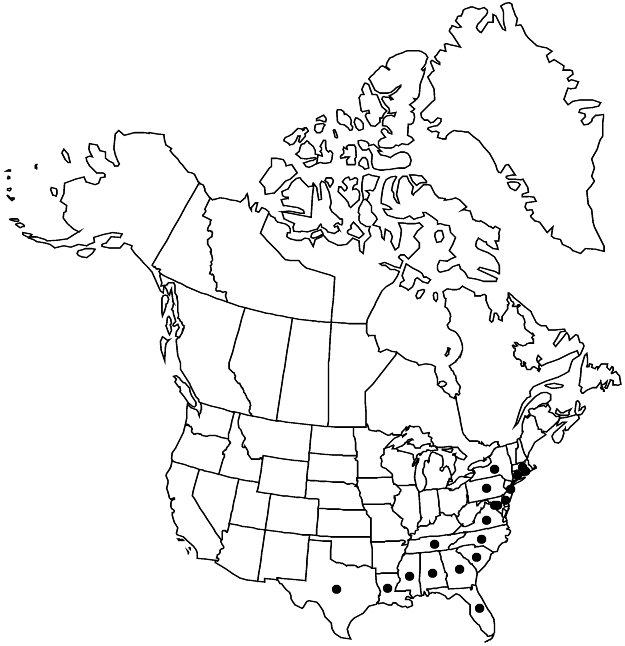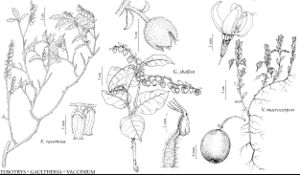Difference between revisions of "Eubotrys racemosa"
Trans. Amer. Philos. Soc., n. s. 8: 269. 1842,.
FNA>Volume Importer |
imported>Volume Importer |
||
| (6 intermediate revisions by 2 users not shown) | |||
| Line 7: | Line 7: | ||
}} | }} | ||
|common_names=Deciduous swamp fetterbush;swamp sweetbells | |common_names=Deciduous swamp fetterbush;swamp sweetbells | ||
| − | |basionyms={{Treatment/ID/ | + | |special_status={{Treatment/ID/Special_status |
| + | |code=F | ||
| + | |label=Illustrated | ||
| + | }}{{Treatment/ID/Special_status | ||
| + | |code=E | ||
| + | |label=Endemic | ||
| + | }} | ||
| + | |basionyms={{Treatment/ID/Basionym | ||
|name=Andromeda racemosa | |name=Andromeda racemosa | ||
|authority=Linnaeus | |authority=Linnaeus | ||
| + | |rank=species | ||
| + | |publication_title=Sp. Pl. | ||
| + | |publication_place=1: 394. 1753 | ||
}} | }} | ||
|synonyms={{Treatment/ID/Synonym | |synonyms={{Treatment/ID/Synonym | ||
|name=Cassandra racemosa | |name=Cassandra racemosa | ||
|authority=(Linnaeus) Spach | |authority=(Linnaeus) Spach | ||
| − | }}{{Treatment/ID/Synonym | + | |rank=species |
| + | }} {{Treatment/ID/Synonym | ||
|name=Eubotrys elongata | |name=Eubotrys elongata | ||
|authority=(Small) Small | |authority=(Small) Small | ||
| − | }}{{Treatment/ID/Synonym | + | |rank=species |
| + | }} {{Treatment/ID/Synonym | ||
|name=Eubotrys racemosa var. elongata | |name=Eubotrys racemosa var. elongata | ||
|authority=(Small) Small | |authority=(Small) Small | ||
| − | }}{{Treatment/ID/Synonym | + | |rank=variety |
| + | }} {{Treatment/ID/Synonym | ||
|name=Leucothoë elongata | |name=Leucothoë elongata | ||
|authority=(Linnaeus) A. Gray | |authority=(Linnaeus) A. Gray | ||
| − | }}{{Treatment/ID/Synonym | + | |rank=species |
| + | }} {{Treatment/ID/Synonym | ||
|name=Leucothoë racemosa | |name=Leucothoë racemosa | ||
|authority=(Linnaeus) D. Don | |authority=(Linnaeus) D. Don | ||
| − | }}{{Treatment/ID/Synonym | + | |rank=species |
| + | }} {{Treatment/ID/Synonym | ||
|name=Leucothoë racemosa var. projecta | |name=Leucothoë racemosa var. projecta | ||
|authority=Fernald | |authority=Fernald | ||
| − | }}{{Treatment/ID/Synonym | + | |rank=variety |
| + | }} {{Treatment/ID/Synonym | ||
|name=Lyonia racemosa | |name=Lyonia racemosa | ||
| − | |authority= | + | |authority= |
| − | }}{{Treatment/ID/Synonym | + | |rank=species |
| + | }} {{Treatment/ID/Synonym | ||
|name=Zenobia racemosa | |name=Zenobia racemosa | ||
| − | |authority= | + | |authority= |
| + | |rank=species | ||
}} | }} | ||
|hierarchy=Ericaceae;Ericaceae subfam. Vaccinioideae;Eubotrys;Eubotrys racemosa | |hierarchy=Ericaceae;Ericaceae subfam. Vaccinioideae;Eubotrys;Eubotrys racemosa | ||
| Line 50: | Line 68: | ||
|elevation=0-400 m | |elevation=0-400 m | ||
|distribution=Ala.;Conn.;Del.;D.C.;Fla.;Ga.;La.;Md.;Mass.;Miss.;N.J.;N.Y.;N.C.;Pa.;R.I.;S.C.;Tenn.;Tex.;Va. | |distribution=Ala.;Conn.;Del.;D.C.;Fla.;Ga.;La.;Md.;Mass.;Miss.;N.J.;N.Y.;N.C.;Pa.;R.I.;S.C.;Tenn.;Tex.;Va. | ||
| − | |discussion=<p>Eubotrys racemosa occurs primarily on the coastal plain; there are scattered records inland from the Hudson Highlands of New York, and from northern Alabama and central and eastern Tennessee.</p> | + | |discussion=<p><i>Eubotrys racemosa</i> occurs primarily on the coastal plain; there are scattered records inland from the Hudson Highlands of New York, and from northern Alabama and central and eastern Tennessee.</p> |
|tables= | |tables= | ||
|references= | |references= | ||
| Line 59: | Line 77: | ||
-->{{#Taxon: | -->{{#Taxon: | ||
name=Eubotrys racemosa | name=Eubotrys racemosa | ||
| − | |||
|authority=(Linnaeus) Nuttall | |authority=(Linnaeus) Nuttall | ||
|rank=species | |rank=species | ||
| Line 73: | Line 90: | ||
|publication title=Trans. Amer. Philos. Soc., n. s. | |publication title=Trans. Amer. Philos. Soc., n. s. | ||
|publication year= | |publication year= | ||
| − | |special status= | + | |special status=Illustrated;Endemic |
| − | |source xml=https:// | + | |source xml=https://bitbucket.org/aafc-mbb/fna-data-curation/src/2e0870ddd59836b60bcf96646a41e87ea5a5943a/coarse_grained_fna_xml/V8/V8_997.xml |
|subfamily=Ericaceae subfam. Vaccinioideae | |subfamily=Ericaceae subfam. Vaccinioideae | ||
|genus=Eubotrys | |genus=Eubotrys | ||
Latest revision as of 22:47, 5 November 2020
Stems erect, (0.3–)1–4 m, branches spreading. Leaves: petiole 1–3 mm; blade 3–8 cm, surfaces pilose on major veins abaxially. Inflorescences (deciduous around anthesis), erect or ascending, secund, straight, 3–5 cm; bracts ± deciduous, lanceolate, 4–5 mm. Flowers: calyx campanulate, sepals lanceolate, 2–3 mm, apex acute; corolla white, 7–9 mm, lobes recurved, glabrous; stamens 2–4 mm; anthers 4-awned, ca. 1.5 mm, thecae divergent distally; ovary glabrous. Capsules 2–3 mm wide. Seeds not winged, wedge- to crescent-shaped, not flat, 1–1.2 mm. 2n = 22.
Phenology: Flowering late spring–summer.
Habitat: Swamps, pond shores, streamheads and their ecotones, blackwater shores and banks, cypress depressions, wet pine flatwoods, wet, sandy, acidic woods
Elevation: 0-400 m
Distribution

Ala., Conn., Del., D.C., Fla., Ga., La., Md., Mass., Miss., N.J., N.Y., N.C., Pa., R.I., S.C., Tenn., Tex., Va.
Discussion
Eubotrys racemosa occurs primarily on the coastal plain; there are scattered records inland from the Hudson Highlands of New York, and from northern Alabama and central and eastern Tennessee.
Selected References
None.
